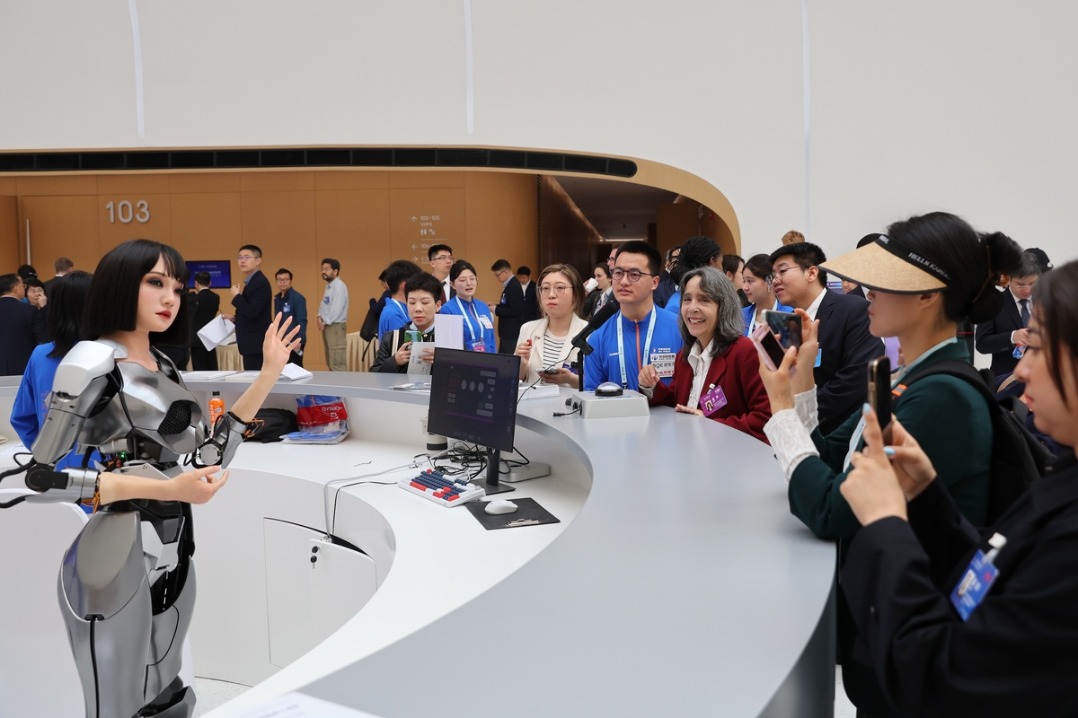'Hardware paradise' fights for its identity

Huaqiangbei diehard traders stay put to keep hub's business culture after revamp. Sophia Luo reports.
For years, the saying "Northern Zhongguancun, Southern Huaqiangbei" has been very much on everyone's lips across China's electronics manufacturing circles, and among the hoards of visitors thronging the country's two most famous technology meccas.
The twin marketplaces, located in Beijing and Shenzhen, and sharing equal renown in vying for the honor of being "China's Silicon Valley", have mirrored the ups and downs in the once flourishing and prosperous electronics trade in the world's second-largest economy.
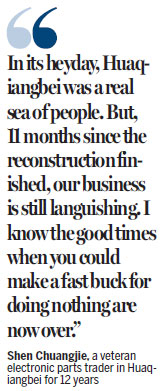
The Huaqiangbei hub, tucked away in tree-lined streets in Shenzhen's upmarket commercial-and-residential Futian district, is acclaimed for wheeling and dealing in a panoply of electronic gadgets under the sun. It made a comeback in January this year after being fenced off for four years to facilitate the construction of the city's fast-expanding metro network.
A newly-built commercial street, wide and clean and now served by the subway stations of Lines 1,2,3 and 7, stretches across the 14,500-square-meter marketplace that timed its take-off with the factories and farmlands being abandoned there more than three decades ago.
But, despite the rather impressive transformation, with a significant increase in foot traffic created by the metro expansion, Huaqiangbei's future seems to hang in the balance.
Shen Chuangjie, who has been dealing in electronic parts, components and kits in Huaqiangbei for some 12 years, sees a new "ritual" emerging in the famed marketplace as new fortune hunters arrive with dreams of making their first pot of gold, and veteran traders make way, moaning the tough times, much like a revolving door.
"Soaring manufacturing costs and the meteoric advent of e-commerce have wiped out almost 80 percent of my business," groans Shen. "But, this is just the tip of the iceberg. The winds of change have been sweeping across Huaqiangbei for years, long before the metro construction started. You know, you've to make a choice - hang on or just go."
In China, with the breakneck pace of change continuing to make headlines nationwide, one may be prescient about the beginning but, when it comes to the home straight, it could be another story. Four years down the road, as in the case of Huaqiangbei, may be enough to make a world of difference.
Over the past four years, the markets for assembled personal computers and low-priced, knock-off mobile phones have taken a big hit from the formidable brand-name makers. Deep-pocketed domestic manufacturers have been relocating their production bases overseas to cut costs, sparking a bitter debate over the economic plight the nation's manufacturing sector is grappling with.
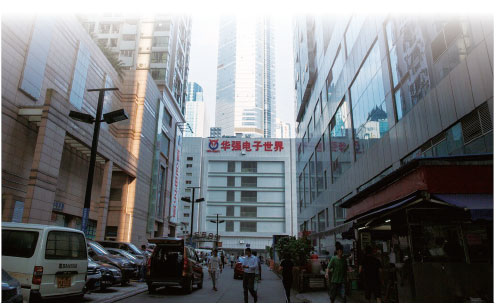
Shenzhen's commercial skyline has turned almost unrecognizable over the years, with the 592-meter-high Ping An Finance Centre, also in Futian district, reaching for the clouds and dethroning Kingkey Finance Tower as the city's tallest landmark building.
Ping An Finance Centre, which is more than twice the height of the 72-story SEG Plaza - Huaqiangbei's iconic edifice that once defined the "speed of Shenzhen" with its record of erecting an average of 2.7 storeys daily - has rendered SEG Plaza nothing more than a memory at the turn of the century.
It was at SEG Plaza that Shen's story unfolded, bearing the imprint of the nationwide "gold rush" in Huaqiangbei. The young man, born and bred in Guangdong province, embarked on his journey to the "Paradise of Hardware" after graduating from high school in 2005 in search of a better life.
A turning point
Shen's uncle had been among the first batch of self-made billionaires in the wild west of Huaqiangbei late last century. On his uncle's advice, Shen and his mother managed to settle down in Huaqiangbei - a move that turned out to be a watershed for the aspiring entrepreneurs.
They dished out 5,000 yuan each month renting a minuscule one-square-meter counter at SEG Plaza from which they plied their stuff, raking in hundreds of thousands of yuan monthly without much ado.
"In the old good days, whatever we sold, people would just rush in snapping them up, so much so that some products were sold out in the blink of an eye although we had no idea what they could be used for," recalls Shen.
At its height, Huaqiangbei was home to some two dozen electronics malls, drawing millions of buyers daily, with annual sales exceeding 26 billion yuan ($4 billion). As many as 13,000 vendors fought it out for business in the gigantic market, selling everything from individual semiconductor chips to roll-up drum kits and hoverboards, earning Huaqiangbei its stature as the "barometer" of China's electronics industry.
Within the multi-floor electronics malls, every booth represented a factory somewhere in southern China's Pearl River Delta megalopolis. It was more than a storefront - it was also an office-cum-daycare place for kids where vendors could tie up almost all of their assets to feed the whole family.
But the tide of change soon crept in. The burgeoning e-commerce trend that hawks almost all sorts of electronics products progressively flexed its muscle in the new millennium. Yet, few people in Huaqiangbei believed it could go so far as to disrupt the market and be a game changer - to the extent of sweeping some traders off their feet over the next couple of years.
"By the time I came to realize the disruptive power of e-commerce, it had overwhelmingly muscled in on my turf," says Shen.
It left him with no choice but to switch nearly 70 percent of his operations online. Although the profit margin for online business hovers at no more than 20 percent, it pales in comparison to the 50-percent for brick-and-mortar business.
Adding to their woes, the world stopped seeing China as a cheap factory. The Pearl River Delta region - the country's traditional manufacturing heartland - bore the brunt of mounting labor and production costs, making the area a literally costly place to sew, weld and assemble.
Shen has seen his overall production costs climb from 25 yuan to as high as 40 yuan, further squeezing his coffers.
"All of a sudden, the early traders in Huaqiangbei are talking about building their own brands and going up the value chain to weather the storm," says Shen. "In its heyday, Huaqiangbei was a real sea of people. But, 11 months since the reconstruction finished, our business is still languishing. I know the good times when you could make a fast buck for doing nothing are now over."
Qu Lijun, general manager of Shenzhen Holokook Technology, says that as the Chinese mainland gets rid of its "sweatshop" label and ascends the industry ladder with a master plan called "Made in China 2025" to boost manufacturing innovation and promote home-grown products, large swaths of low-margin, low value-added manufacturers have been rendered uncompetitive.
Real mind blower
But, while rejecting talk of Huaqiangbei's withering status, he believes the real mind blower for what's happening in this geek's wonderland is that screwing things together will not drive business any longer.
The country's "super consumers" have now gone beyond mimicking the patterns of the more sophisticated Western shoppers to being the trendsetters and innovators, notes Lin Wenyu, founder of geekview.cn website.
"Today, a product with no discernible brands associated with it or even an agreed upon name may not come to dominate the market overnight as before," Lin says. "In Huaqiangbei, production on contract for global brands - the so called original equipment manufacturer - is nothing new. But, with the increasingly fickle and choosy customers, and the already razor-thin profit margins, only those with much care for branding may come to the fore."
"The market is pragmatic and realistic. In Huaqiangbei, it used to be the case that when a certain kind of products proved to be well sold, vendors would start selling the same basic product all at once with little care for branding or marketing," adds Qu. "But, this doesn't work. The market tests everything. It becomes really difficult now to cash in on a passing fad. Beyond the product itself, branding, packaging and design equally matter."
This makes the strange and scrappy underground world of shanzhai - copycat electronics - gradually lose its place in Huaqiangbei's complex, sophisticated manufacturing ecosystem.
"The marketplace has long made its fortune with almost total disregard for intellectual property rights. It takes years of hard work today to remove its 'capital of knock-off' label and rebuild trust," reckons Wang Zichen, general manager assistant of Huaqiangbei International Maker Center.
"Small and medium-sized traders, with no expertise and knowhow, may end up being forced out," she warns.
"There's no shortage of stories about building iPhone or anything else from scratch in Huaqiangbei. But, as Shenzhen reinvents itself by staking its future growth on technology, innovation and entrepreneurship, Huaqiangbei should not settle for the role of a hardware supply chain," she says.
"Makers" - a buzzword for people who are do-it-yourself hardware designers, inventors and budding entrepreneurs - are now said to hold a beacon of hope for the once teeming marketplace.
For years, high-tech entrepreneurs have made the pilgrimage to Shenzhen, or Huaqiangbei to be precise, meeting manufacturers and suppliers face to face, testing their ideas and finding solutions for their prototypes.
"This makes Huaqiangbei more of a trading center. It is also a magnet for the young, tech-savvy crowd of twenty- and thirty-somethings," says Qu, who is also co-founder and operating director of SegMaker, a startup incubator of the marketplace's developer SEG Electronics Market.
"The sprawling marketplace is the birthplace of tech giants Tencent, Huawei and Kingdee. Tencent's original office, as a living embodiment of the Shenzhen dream, is still kept in SegMaker," insists Qu.
"The tools are there, setting the stage for any promising startup to make the journey from a Huaqiangbei booth to a stock market listing," he adds with a stint of optimism.
Shen would like people to call him "MJ" now - a name he uses on a new calling card to get himself acquainted with overseas makers. Some customers have made a video on his products and posted it on YouTube, drawing crowds of makers to Huaqiangbei to meet him.
Amid the renewed tussle, Shen believes he's already half-way through in the battle to penetrate the makers' club.
"In the past, hardware vendors and makers were, by and large, isolated in Huaqiangbei. Now, I can see some free flow and exchange," he says. "Having failed to get a headstart in the online business arena, I don't want to miss the boat this time."
Steep learning curve
But, the learning curve can be fairly steep. "Some makers had asked me at first sight whether I have coding knowledge. When they knew I did not, they appeared to lose interest in me and my products," says Shen.
"The marketplace is still teeming with a legion of traders who may lack the foresight or ability to make a change. Only a few people do hit the road," he adds.
To be sure, Shenzhen, the fishing village-turned-megacity hailed as the poster child of China's economic miracle, is becoming the new frontier for technology. The electronics market, either online or offline, is under the growing influence of the Pareto principle, where a tiny few of deep-pocketed brand-name makers amass the overwhelmingly majority of the market share and wealth.
"But whether Huaqiangbei, the traditional dazzling hub of small-and medium-sized vendors, could get on board, no one knows for sure," says Lin.
"For years, it's tempting to compare Huaqiangbei with Akihabara in Tokyo. Although Japan is in fast retreat in the world of electronics, Akihabara's appeal is somewhat kept alive with the country's well-established anime industry," he argues.
"But, what really defines the culture of Huaqiangbei? It may lie in the fresh-faced and thick-specs makers, the latest trending gadgets like hoverboards and micro drones, or the experienced hardware vendor who turns out to be a 'black technology expert'. Yet, they are rolling on their own for the time being.
"It takes time to orchestrate all the players and see that its culture comes of age. But, the question is having done so, is there time left for Huaqiangbei to catch up with Shenzhen's high-speed ambitions?"
Contact the writer at
sophia@chinadailyhk.com
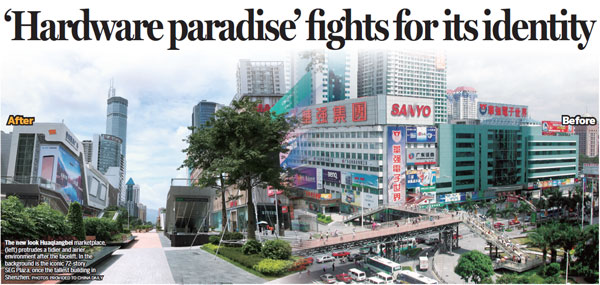
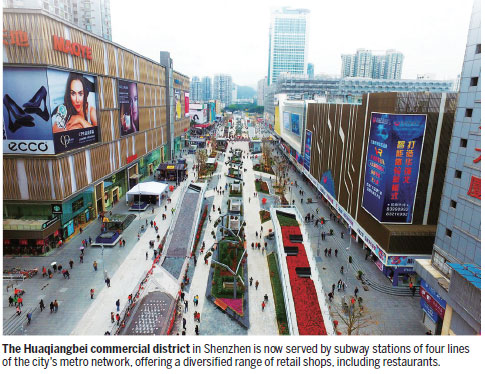
(HK Edition 11/24/2017 page8)
Today's Top News
- China, US must decide the future path of ties, Wang tells Blinken
- China, Latin America eye close space collaboration
- China flays overseas talk about 'overcapacity'
- 'Nuclear-free world' a Japanese ploy to dispose toxic water
- AUKUS expansion to 'undermine peace'
- Pandas headed for Madrid in sign of bilateral friendship

















